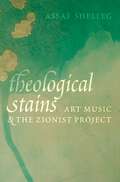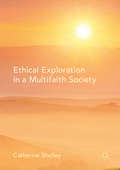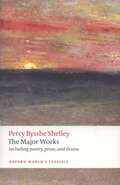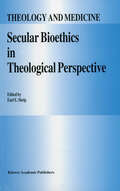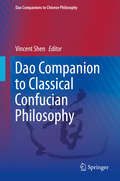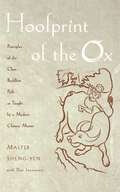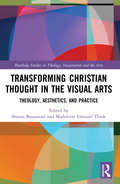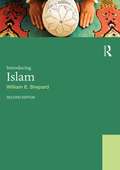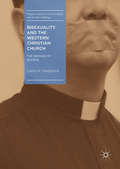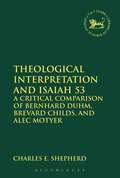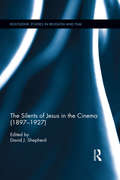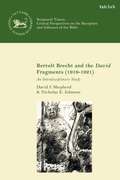- Table View
- List View
Theological Stains: Art Music and the Zionist Project
by Assaf ShellegTheological Stains offers the first in-depth study of the development of art music in Israel from the mid-twentieth century to the turn of the twenty-first. In a bold and deeply researched account, author Assaf Shelleg explores the theological grammar of Zionism and its impact on the art music written by emigrant and native composers. He argues that Israeli art music, caught in the tension between a bibliocentric territorial nationalism on the one hand and the histories of deterritorialized Jewish diasporic cultures on the other, often features elements of both of these competing narratives. Even as composers critically engaged with the Zionist paradigm, they often reproduced its tropes and symbols, thereby creating aesthetic hybrids with 'theological stains.' Drawing on newly uncovered archives of composers' autobiographical writings and musical sketches, Shelleg closely examines the aesthetic strategies that different artists used to grapple with established nationalist representations. As he puts the history of Israeli art music in conversation with modern Hebrew literature, he weaves a rich tapestry of Israeli culture and the ways in which it engaged with key social and political developments throughout the second half of the twentieth century. In analyzing Israeli music and literature against the backdrop of conflicts over territory, nation, and ethnicity, Theological Stains provides a revelatory look at the complex relationship between art and politics in Israel.
Healing for the Soul: Richard Smallwood, the Vamp, and the Gospel Imagination (AMS Studies in Music)
by Braxton D. ShelleyBetween the first and last words of a black gospel song, musical sound acquires spiritual power. During this unfolding, a variety of techniques facilitate musical and physical transformation. The most important of these is a repetitive musical cycle known by names including the run, the drive, the special, and the vamp. Through its combination of reiteration and intensification, the vamp turns song lyrics into something more potent. While many musical traditions use vamps to fill space, or occupy time in preparation for another, more important event, in gospel, vamps are the main event. Why is the vamp so central to the black gospel tradition? What work-musical, cultural, and spiritual-does the gospel vamp do? And what does the vamp reveal about the transformative power of black gospel more broadly? This book explores the vamp's essential place in black gospel song, arguing that these climactic musical cycles turn worship services into transcendent events. A defining feature of contemporary gospel, the vamp links individual performances to their generic contexts. An exemplar of African American musical practice, the vamp connects gospel songs to a venerable lineage of black sacred expression. As it generates emotive and physical intensity, the vamp helps believers access an embodied experience of the invisible, moving between this world and another in their musical practice of faith. The vamp, then, is a musical, cultural, and religious interface, which gives vent to a system of belief, performance, and reception that author Braxton D. Shelley calls the Gospel Imagination. In the Gospel Imagination, the vamp offers proof that musical sound can turn spiritual power into a physical reality-a divine presence in human bodies.
Healing for the Soul: Richard Smallwood, the Vamp, and the Gospel Imagination (AMS Studies in Music)
by Braxton D. ShelleyBetween the first and last words of a black gospel song, musical sound acquires spiritual power. During this unfolding, a variety of techniques facilitate musical and physical transformation. The most important of these is a repetitive musical cycle known by names including the run, the drive, the special, and the vamp. Through its combination of reiteration and intensification, the vamp turns song lyrics into something more potent. While many musical traditions use vamps to fill space, or occupy time in preparation for another, more important event, in gospel, vamps are the main event. Why is the vamp so central to the black gospel tradition? What work-musical, cultural, and spiritual-does the gospel vamp do? And what does the vamp reveal about the transformative power of black gospel more broadly? This book explores the vamp's essential place in black gospel song, arguing that these climactic musical cycles turn worship services into transcendent events. A defining feature of contemporary gospel, the vamp links individual performances to their generic contexts. An exemplar of African American musical practice, the vamp connects gospel songs to a venerable lineage of black sacred expression. As it generates emotive and physical intensity, the vamp helps believers access an embodied experience of the invisible, moving between this world and another in their musical practice of faith. The vamp, then, is a musical, cultural, and religious interface, which gives vent to a system of belief, performance, and reception that author Braxton D. Shelley calls the Gospel Imagination. In the Gospel Imagination, the vamp offers proof that musical sound can turn spiritual power into a physical reality-a divine presence in human bodies.
Ethical Exploration in a Multifaith Society
by Catherine ShelleyThis book considers the theory and application of ethics for a multifaith society. Much ethics taught in the UK has been dominated by Christian ethics, their relation to secularism and by the Enlightenment’s reaction against theology as a basis for ethical thought. In contrast to these perspectives this book brings secular and theological ethics into dialogue, considering the degree to which secular ethics has common roots with theological perspectives from various traditions. The book assesses the application of ethical and theological principles in today’s multifaith society. Aiming to enhance ethical understanding and awareness across divergent worldviews, identifying at what points divergence does occur, the author examines topics such as reason and ethics in theology, natural law, utilitarianism and deontology and differences of approach to interpreting religious scriptures. The focus on ethical methods is illustrated through topical concerns in religion and ethics, for example sexuality, marriage and education and religion in relation to global ethics and human rights.
Ethical Exploration in a Multifaith Society
by Catherine ShelleyThis book considers the theory and application of ethics for a multifaith society. Much ethics taught in the UK has been dominated by Christian ethics, their relation to secularism and by the Enlightenment’s reaction against theology as a basis for ethical thought. In contrast to these perspectives this book brings secular and theological ethics into dialogue, considering the degree to which secular ethics has common roots with theological perspectives from various traditions. The book assesses the application of ethical and theological principles in today’s multifaith society. Aiming to enhance ethical understanding and awareness across divergent worldviews, identifying at what points divergence does occur, the author examines topics such as reason and ethics in theology, natural law, utilitarianism and deontology and differences of approach to interpreting religious scriptures. The focus on ethical methods is illustrated through topical concerns in religion and ethics, for example sexuality, marriage and education and religion in relation to global ethics and human rights.
The Major Works (Oxford World's Classics): (pdf)
by Percy Bysshe Shelley Zachary Leader Michael O'NeillPercy Bysshe Shelley (1792-1822) was a Romantic poet of radical imaginings, living in an age of change. His tempestuous life and friendship with Byron, and his tragically early death, at times threatened to overwhelm his legacy as a poet, but today his standing as one of the foremost English authors is assured. This freshly edited collection--the fullest one-volume selection in English--includes all but one of the longer poems, from Queen Mab onwards, in their entirety. Only Laon and Cythna is excerpted, in a generous selection. As well as works such asPrometheus Unbound, The Mask of Anarchy, and Adonais, the volume includes a wide range of Shelley's shorter poems and much of his major prose, including A Defence of Poetry and almost all of A Philosophical View of Reform. Shelley emerges from these pages as a passionate and eloquent opponent of tyranny and a champion of human possibility. About the Series: For over 100 years Oxford World's Classics has made available the broadest spectrum of literature from around the globe. Each affordable volume reflects Oxford's commitment to scholarship, providing the most accurate text plus a wealth of other valuable features, including expert introductions by leading authorities, voluminous notes to clarify the text, up-to-date bibliographies for further study, and much more.
Secular Bioethics in Theological Perspective (Theology and Medicine #8)
by E. E. ShelpTheologians and theologically educated participants in discussions of bioethics have been placed on the defensive during recent years. The dominance of religious perspectives and theological voices that marked the emergence and establishment of "bioethics" in the late 1960s and 1970s has eroded steadily as philosophers, lawyers, and others have relativized their role and influ ence, at best, or dismissed it entirely, at worst. The secularization of bioethics, which has occurred for a variety of reasons, has prompted some prominent writers to reflect on what has been lost. Daniel Callahan, for example writes, " . . . whatever the ultimate truth status of religious perspectives, they have provided a way of looking at the world and understanding one's own life that has a fecundity and uniqueness not matched by philosophy, law, or political theory. Those of us who have lost our reli gious faith may be glad that we have discovered what we take to be the reality of things, but we can still recognize that we have also lost something of great value as well: the faith, vision, insights, and experience of whole peoples and traditions who, no less than we unbelievers, struggled to make sense of things. That those goods are part of a garment we no longer want to wear does not make their loss anything other than still a loss; and it is not a neglible one" ([2], p. 2).
Dao Companion to Classical Confucian Philosophy (Dao Companions to Chinese Philosophy #3)
by Vincent ShenThis volume presents both a historical and a systematic examination of the philosophy of classical Confucianism. Taking into account newly unearthed materials and the most recent scholarship, it features contributions by experts in the field, ranging from senior scholars to outstanding early career scholars.The book first presents the historical development of classical Confucianism, detailing its development amidst a fading ancient political theology and a rising wave of creative humanism. It examines the development of the philosophical ideas of Confucius as well as his disciples and his grandson Zisi, the Zisi-Mencius School, Mencius, and Xunzi. Together with this historical development, the book analyzes and critically assesses the philosophy in the Confucian Classics and other major works of these philosophers. The second part systematically examines such philosophical issues as feeling and emotion, the aesthetic appreciation of music, wisdom in poetry, moral psychology, virtue ethics, political thoughts, the relation with the Ultimate Reality, and the concept of harmony in Confucianism. The Philosophy of Classical Confucianism offers an unparalleled examination to the philosophers, basic texts and philosophical concepts and ideas of Classical Confucianism as well as the recently unearthed bamboo slips related to Classical Confucianism. It will prove itself a valuable reference to undergraduate and postgraduate university students and teachers in philosophy, Chinese history, History, Chinese language and Culture.
Hoofprint of the Ox: Principles of the Chan Buddhist Path as Taught by a Modern Chinese Master
by Master Sheng-yenRevered by Buddhists in the United States and China, Master Sheng-yen shares his wisdom and teachings in this first comprehensive English primer of Chan, the Chinese tradition of Buddhism that inspired Japanese Zen. Often misunderstood as a system of mind games, the Chan path leads to enlightenment through apparent contradiction. While demanding the mental and physical discipline of traditional Buddhist doctrine, it asserts that wisdom (Buddha-nature) is innate and immediate in all living beings, and thus not to be achieved through devotion to the strictures of religious practice. You arrive without departing. Master Sheng-yen provides an unprecedented understanding of Chan, its precepts, and its practice. Beginning with a basic overview of Buddhism and meditation, Hoofprint of the Ox details the progressive mental exercises traditionally followed by all Buddhists. Known as the Three Disciplines, these procedures develop moral purity, meditative concentration, and enlightening insight through the "stilling" of the mind. Master Sheng-yen then expounds Chan Buddhism, recounting its centuries-old history in China and illuminating its fundamental tenets. He contemplates the nature of Buddhahood, specifies the physical and mental prerequisites for beginning Chan practice, and humbly considers what it means to be an enlightened Chan master. Drawing its title from a famous series of pictures that symbolizes the Chan path as the search of an ox-herd for his wayward ox, Hoofprint of the Ox is an inspirational guide to self-discovery through mental transformation. A profound contribution to Western understanding of Chan and Zen, this book is intended for practicing Buddhists as well as anyone interested in learning about the Buddhist path.
Transforming Christian Thought in the Visual Arts: Theology, Aesthetics, and Practice (Routledge Studies in Theology, Imagination and the Arts)
by Sheona Beaumont and Madeleine Emerald ThieleThis volume explores how the visual arts are presenting and responding to Christian theology and demonstrates how modern and contemporary artists and artworks have actively engaged in conversation with Christianity. Modern intellectual enquiry has often been reluctant to engage theology as an enriching or useful form of visual analysis, but critics are increasingly revisiting religious narratives and Christian thought in pursuit of understanding our present-day visual culture. In this book an international group of contributors demonstrate how theology is often implicit within artworks and how, regardless of a viewer’s personal faith, it can become implicit in a viewer’s visual encounter. Their observations include deliberate juxtaposition of Christian symbols, imaginative play with theologies, the validation of non-confessional or secular public engagement, and inversions of biblical interpretation. Case studies such as an interactive Easter, glow-sticks as sacrament, and visualisation of the Bible’s polyphonic voices enrich this discussion. Together, they call for a greater interpretative generosity and more nuance around theology’s cultural contexts in the modern era. By engaging with theology, culture, and the visual art, this collection offers a fresh lens through which to see the interaction of religion and art. As such, it will be of great use to those working in Religion and the Arts, Visual Art, Material Religion, Theology, Aesthetics, and Cultural Studies.
Introducing Islam (PDF)
by William ShepardJust what is Islam and what does it mean to be a Muslim in the world today? Since the events of 9/11 and 7/7, Islam has become one of the most controversial and misunderstood religions in the world. Introducing Islam encourages students to put aside their preconceptions and explore this fascinating religion. William Shepard traces the history of Islam from its origins in the life and career of Mohammed, through its classical expressions, to its interactions with the West in the modern world. A chapter is devoted to each major topic, including The Quran, Islamic law, Islamic theology, and the Sufi movement, as well as community rituals and Islamic art and culture. There is a survey of modern developments and four chapters are dedicated to individual countries, Turkey, Iran, Egypt and Indonesia. Fully revised and updated, the second edition of this core textbook adds crucial material on contemporary issues such as women in Islam and democratization and human rights. Illustrated throughout, the book also includes learning objectives, a glossary of key Arabic terms, comprehensive further reading lists and critical thinking boxes, helping students to critically engage with the material in each chapter. Further teaching and learning resources are available on the companion website at www.routledge.com/cw/shepard .This book continues to be essential reading for students of Islam worldwide.
Challenging the New Atheism: Pragmatic Confrontations in the Philosophy of Religion (Routledge Studies in American Philosophy)
by Aaron Pratt ShepherdThis book presents a pragmatic response to arguments against religion made by the New Atheism movement. The author argues that analytic and empirical philosophies of religion—the mainstream approaches in contemporary philosophy of religion—are methodologically unequipped to address the “Threefold Challenge” made by popular New Atheist thinkers such as Richard Dawkins, Sam Harris, Christopher Hitchens, and Daniel Dennett. The book has three primary motivations. First, it provides an interpretation of the New Atheist movement that treats their claims as philosophical arguments and not just rhetorical exercises or demagoguery. Second, it assesses and responds to these claims by elaborating four distinct contemporary philosophical perspectives— analytic philosophy, empirical philosophy, continental philosophy, and pragmatism—as well as contextualizing these perspectives in the history of the philosophy of religion. Finally, the book offers a metaphilosophical critique, returning again and again to the question of method. In the end, the author settles upon a modified version of pragmatism that he concludes is best suited for articulating the terms and stakes of the God Debate. Challenging the New Atheism will be of interest to scholars and students of American philosophy and philosophy of religion.
Challenging the New Atheism: Pragmatic Confrontations in the Philosophy of Religion (Routledge Studies in American Philosophy)
by Aaron Pratt ShepherdThis book presents a pragmatic response to arguments against religion made by the New Atheism movement. The author argues that analytic and empirical philosophies of religion—the mainstream approaches in contemporary philosophy of religion—are methodologically unequipped to address the “Threefold Challenge” made by popular New Atheist thinkers such as Richard Dawkins, Sam Harris, Christopher Hitchens, and Daniel Dennett. The book has three primary motivations. First, it provides an interpretation of the New Atheist movement that treats their claims as philosophical arguments and not just rhetorical exercises or demagoguery. Second, it assesses and responds to these claims by elaborating four distinct contemporary philosophical perspectives— analytic philosophy, empirical philosophy, continental philosophy, and pragmatism—as well as contextualizing these perspectives in the history of the philosophy of religion. Finally, the book offers a metaphilosophical critique, returning again and again to the question of method. In the end, the author settles upon a modified version of pragmatism that he concludes is best suited for articulating the terms and stakes of the God Debate. Challenging the New Atheism will be of interest to scholars and students of American philosophy and philosophy of religion.
Bisexuality and the Western Christian Church: The Damage of Silence (Palgrave Studies in Lived Religion and Societal Challenges)
by Carol A. ShepherdThis book critically examines the lived experiences of bisexual Christians across a range of Christian traditions in the UK and the USA. Shepherd assesses whether current data on elevated rates of depressive illnesses among bisexual people also apply to the bisexual Christian community. Drawing on data collected by the author on bisexual Christians across the lifespan, the book uncovers shocking incidences of biphobia and bi erasure in the Church. Widespread ignorance among pastors of middle sexualities outside of the hetero-/homonormative binary is revealed as well as a corresponding absence of appropriate support resources. Bisexuality and the Western Christian Church will be of interest to students and scholars across a range of disciplines, including gender studies, applied theology, sociology and social psychology. It is also important reading for clergy, and LGBT faith organisations. With a Foreword by Eric Anderson, Professor of Sport, Masculinities, and Sexualities, University of Winchester, UK.
Bisexuality and the Western Christian Church: The Damage of Silence (Palgrave Studies in Lived Religion and Societal Challenges)
by Carol A. ShepherdThis book critically examines the lived experiences of bisexual Christians across a range of Christian traditions in the UK and the USA. Shepherd assesses whether current data on elevated rates of depressive illnesses among bisexual people also apply to the bisexual Christian community. Drawing on data collected by the author on bisexual Christians across the lifespan, the book uncovers shocking incidences of biphobia and bi erasure in the Church. Widespread ignorance among pastors of middle sexualities outside of the hetero-/homonormative binary is revealed as well as a corresponding absence of appropriate support resources. Bisexuality and the Western Christian Church will be of interest to students and scholars across a range of disciplines, including gender studies, applied theology, sociology and social psychology. It is also important reading for clergy, and LGBT faith organisations. With a Foreword by Eric Anderson, Professor of Sport, Masculinities, and Sexualities, University of Winchester, UK.
Theological Interpretation and Isaiah 53: A Critical Comparison of Bernhard Duhm, Brevard Childs, and Alec Motyer (The Library of Hebrew Bible/Old Testament Studies #598)
by Charles E. ShepherdThis study brings together the hermeneutical approaches of three Old Testament scholars, specifically as they pertain to the interpretation of Isaiah 52.13-53.12 in the framework of Christian theology. Contemporary discourse and hermeneutical discussions have led to the development of a point of confusion in theological hermeneutics, focusing on what relationship older frames of reference may have with those more recent. Bernhard Duhm is presented as a history-of-Religion scholar who does not easily abide by popular understandings of that school. Brevard Childs moves outward from particular historical judgments regarding the nature of redaction and form criticism, attempting to arrive at a proximately theological reading of the poem. Alec Motyer's evangelical commitments represent a large constituency of contemporary theological readership, and a popular understanding of Isaiah 53. Following a summary and critical engagement of each interpreter on his own terms, the study analyzes the use of rhetoric behind the respective readings of Isaiah 53, and proposes theological reading as a highly eclectic undertaking, distanced from the demarcations of 'pre-critical', 'critical', and 'post-critical'.
The Silents of Jesus in the Cinema (Routledge Studies in Religion and Film)
by David ShepherdWhile Jesus has attracted the sporadic interest of film-makers since the epics of the Sixties, it is often forgotten that between the advent of motion pictures in the 1890s and the close of the "silent" era at the end of the 1920s, some of the longest, most expensive and most watched films on both sides of the Atlantic were focused on the Life and Passion of the Christ. Drawing upon rarely seen archival footage and the work of both the era’s most important directors (e.g. Alice Guy, Ferdinand Zecca, Sidney Olcott, D.W. Griffith, Carl Dreyer, and C.B. DeMille) and others who have been all but forgotten, this collection of essays offers a representative survey of the Silents of Jesus, illustrating the ways in which the earliest films and those which followed were influenced by a multiplicity of factors. Written by leading scholars in biblical and early film studies this collection explores the ways in which the Silents of Jesus were shaped not only by the performing and visual arts of the nineteenth century and the technological challenges and opportunities of a new medium and industry, but also by the artistic, theological and ideological predilections of studios and directors, and the expectations of audiences as the genre evolved. Taken together, the essays collected here offer a seminal treatment of the genesis and early evolution of the cinematic Jesus.
King David, Innocent Blood, and Bloodguilt
by David J. ShepherdOf all the characters bequeathed to us by the Hebrew Bible, none is more compelling or complex than David. Divinely blessed, musically gifted, brave, and eloquent, David's famous slaying of Goliath also confirms that he is a redoubtable man of war. Yet, when his son Absalom rebels, David is dogged by the accusation than he will lose his kingdom because he is not merely a man of war, but a man of 'bloods' - guilty of shedding innocent blood. In this book, for the first time, this language of 'innocent blood' and 'bloodguilt' is traced throughout David's story in the books of Samuel and 1 Kings. The theme emerges initially in Saul's pursuit of David and resurfaces regularly as David rises and men like Nabal, Saul, Ishbosheth, and Abner fall. Innocent blood and bloodguilt also turn out to be central to David's reign. This is seen in a surprising way in David's killing of Uriah, but also in the subsequent deaths of his sons, Amnon and Absalom, his general, Amasa, and even in David's encounters with Shimei. The problem rears its head again when the innocent blood of the Gibeonites shed by Saul comes back to haunt David's kingdom. Finally, the problem reappears when Solomon succeeds David and orchestrates the executions of Joab and Shimei, and the exile of Abiathar. Attending carefully to the text and drawing extensively on previous biblical scholarship, David J. Shepherd suggests that innocent blood is not only a pre-eminent concern of David, and his story in Samuel and 1 Kings, but also shapes the entirety of David's history.
King David, Innocent Blood, and Bloodguilt
by David J. ShepherdOf all the characters bequeathed to us by the Hebrew Bible, none is more compelling or complex than David. Divinely blessed, musically gifted, brave, and eloquent, David's famous slaying of Goliath also confirms that he is a redoubtable man of war. Yet, when his son Absalom rebels, David is dogged by the accusation than he will lose his kingdom because he is not merely a man of war, but a man of 'bloods' - guilty of shedding innocent blood. In this book, for the first time, this language of 'innocent blood' and 'bloodguilt' is traced throughout David's story in the books of Samuel and 1 Kings. The theme emerges initially in Saul's pursuit of David and resurfaces regularly as David rises and men like Nabal, Saul, Ishbosheth, and Abner fall. Innocent blood and bloodguilt also turn out to be central to David's reign. This is seen in a surprising way in David's killing of Uriah, but also in the subsequent deaths of his sons, Amnon and Absalom, his general, Amasa, and even in David's encounters with Shimei. The problem rears its head again when the innocent blood of the Gibeonites shed by Saul comes back to haunt David's kingdom. Finally, the problem reappears when Solomon succeeds David and orchestrates the executions of Joab and Shimei, and the exile of Abiathar. Attending carefully to the text and drawing extensively on previous biblical scholarship, David J. Shepherd suggests that innocent blood is not only a pre-eminent concern of David, and his story in Samuel and 1 Kings, but also shapes the entirety of David's history.
The Silents of Jesus in the Cinema (Routledge Studies in Religion and Film)
by David J. ShepherdWhile Jesus has attracted the sporadic interest of film-makers since the epics of the Sixties, it is often forgotten that between the advent of motion pictures in the 1890s and the close of the "silent" era at the end of the 1920s, some of the longest, most expensive and most watched films on both sides of the Atlantic were focused on the Life and Passion of the Christ. Drawing upon rarely seen archival footage and the work of both the era’s most important directors (e.g. Alice Guy, Ferdinand Zecca, Sidney Olcott, D.W. Griffith, Carl Dreyer, and C.B. DeMille) and others who have been all but forgotten, this collection of essays offers a representative survey of the Silents of Jesus, illustrating the ways in which the earliest films and those which followed were influenced by a multiplicity of factors. Written by leading scholars in biblical and early film studies this collection explores the ways in which the Silents of Jesus were shaped not only by the performing and visual arts of the nineteenth century and the technological challenges and opportunities of a new medium and industry, but also by the artistic, theological and ideological predilections of studios and directors, and the expectations of audiences as the genre evolved. Taken together, the essays collected here offer a seminal treatment of the genesis and early evolution of the cinematic Jesus.
Bertolt Brecht and the David Fragments: An Interdisciplinary Study (The Library of Hebrew Bible/Old Testament Studies)
by David J. Shepherd Nicholas E. JohnsonThis volume offers an examination of Brecht's largely forgotten theatrical fragments of a life of David, written just after the Great War but prior to Brecht winning the Kleist Prize in 1922 and the acclaim that would launch hisextraordinary career. David J. Shepherd and Nicholas E. Johnson take as their starting point Brecht's own diaries from the time, which offer a vivid picture of the young Brecht shuttling between Munich and the family home in Augsburg, surrounded by friends, torn between women, desperate for success, and all the while with 'David on the brain'.The analysis of Brecht's David, along with his notebooks and diaries, reveals significant connections between the reception of the Biblical David and one of Germany's most tumultuous cultural periods. Drawing on theatrical experiments conducted with an ensemble from Trinity College Dublin, this volume includes the first ever translation of the David fragments in English, an extensive discussion of the theatrical afterlife of David in the early twentieth century as well as new interdisciplinary insights into the early Brecht: a writer entranced by the biblical David and utterly committed to translating the biblical tradition into his own evolving theatrical idiom.
Bertolt Brecht and the David Fragments: An Interdisciplinary Study (The Library of Hebrew Bible/Old Testament Studies)
by David J. Shepherd Nicholas E. JohnsonThis volume offers an examination of Brecht's largely forgotten theatrical fragments of a life of David, written just after the Great War but prior to Brecht winning the Kleist Prize in 1922 and the acclaim that would launch hisextraordinary career. David J. Shepherd and Nicholas E. Johnson take as their starting point Brecht's own diaries from the time, which offer a vivid picture of the young Brecht shuttling between Munich and the family home in Augsburg, surrounded by friends, torn between women, desperate for success, and all the while with 'David on the brain'.The analysis of Brecht's David, along with his notebooks and diaries, reveals significant connections between the reception of the Biblical David and one of Germany's most tumultuous cultural periods. Drawing on theatrical experiments conducted with an ensemble from Trinity College Dublin, this volume includes the first ever translation of the David fragments in English, an extensive discussion of the theatrical afterlife of David in the early twentieth century as well as new interdisciplinary insights into the early Brecht: a writer entranced by the biblical David and utterly committed to translating the biblical tradition into his own evolving theatrical idiom.
Ninian Smart on World Religions: Volume 2: Traditions and the Challenges of Modernity
by John J. ShepherdNinian Smart came to public prominence as the founding Professor of the first British university Department of Religious Studies in the late 1960s. His pioneering views on education in religion proved hugely influential at all levels, from primary schools to academic teaching and research. An unending string of publications, many of them accessible to the general public, sustained a reputation that became worldwide. Here, for the first time, a selection of Ninian Smart's wide-ranging writings is organised systematically under a set of categories which both comprehend and also illuminate his varied output over a career spanning half a century. The editor, John Shepherd, was Principal Lecturer in Religion and Philosophy at the University of Cumbria. He first met Smart as a postgraduate student, and recently helped establish the Ninian Smart Archive at the University of Lancaster.
Ninian Smart on World Religions: Volume 2: Traditions and the Challenges of Modernity
by John J. ShepherdNinian Smart came to public prominence as the founding Professor of the first British university Department of Religious Studies in the late 1960s. His pioneering views on education in religion proved hugely influential at all levels, from primary schools to academic teaching and research. An unending string of publications, many of them accessible to the general public, sustained a reputation that became worldwide. Here, for the first time, a selection of Ninian Smart's wide-ranging writings is organised systematically under a set of categories which both comprehend and also illuminate his varied output over a career spanning half a century. The editor, John Shepherd, was Principal Lecturer in Religion and Philosophy at the University of Cumbria. He first met Smart as a postgraduate student, and recently helped establish the Ninian Smart Archive at the University of Lancaster.
